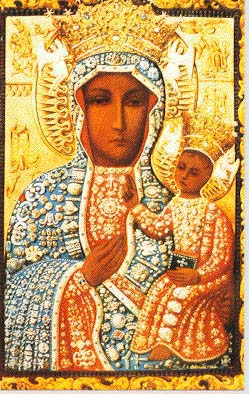
It is doubtful whether any other representation of Our Blessed Mother with Her Divine Child, posses a more ancient and glorious history than the painting of Our Lady of Czestochowa.
Tradition tells us that St. Luke painted it on the top of a cypress wood table which came from the home of the Holy Family. At the request of the faithful, Mary sat for the portrait. Mary was pleased with the finished portrait, "My grace shall accompany it", and so began the miraculous history of the painting.
Venerated for nearly 300 years while hidden in Jerusalem, the painting was discovered by St. Helen while she was searching for the True Cross. She brought it back to Constantinople and presented it to her son, Constantine the Great, first Christian Emperor of Rome. Constantine built a chapel for the portrait and where it remained in for five centuries.
Miracle upon miracle was attributed to the intercession of Mary by persons praying before the portrait. Over the years, many enemies laid siege to Constantinople. The chapel became a center of hope for the people of the city. During one attack the city seemed ready to fall but the people rallied to the painting and the city was saved. Another time the city was under attack and the chapel caught fire. Everything was destroyed except a small section of wall upon which hung the painting of Mary and Jesus. The intense heat and soot from the fire had darkened the already dark olive features of Mary and Jesus.
Eventually it was given as a gift by the Byzantine Emperor to a Ruthenian nobleman. The portrait was brought to Kiev and installed in the Royal Palace of Belz. It remained there for 579 years.
In 1382 the painting received an injury from invading Tartar's. An arrow pierced it, leaving a scar which is still visible on the neck. Concerned with the safety of the painting, Prince Ladislaus Opolski decided to move it to one of his castles in Upper Silesia.
On the brow of a hill called Jasna Gora (bright hill) within a few paces of the town of Czestochowa, the horses drawing the wagon with the painting stopped. No amount of coaxing or goading could make them go on. Mary appeared to Ladislaus and told him this was to be Her new home. The Miraculous Image was placed in a chapel and given to the care of the Basilian monks of the Greek Rite. A few years later, Prince Ladislaus gave it over to the Latin Rite Hermits of Saint Paul who are still there to this day.
The year 1382 begins the remarkable record history of this miraculous painting. If figured in the heroic successful defense of Poland against invaders who were enemies of the Catholic Church. Over time, the monastery as Jasna Gora became a monastic fortress and focal point of Polish nationalism.
In 1655 the monastery held out against a mighty Swedish army. In 1683 it was the Turks and in 1920 the Bolsheviks. As a result, Our Lady of Czestochowa was crowned as Queen of Poland (feast is May 3).
During all these stirring historical events the painting did not escape desecration and mutilation. In 1430 Hussites sacked the monastery. Pillaging they loaded all the treasures of Jasna Gora into wagons. the horses pulling the wagon with the painting would not move. The Hussites, threw the painting off the wagon and the horses moved. One of the raiders seeing the jewels and gold covering the painting slashed at it with sabers. Cutting twice into the right cheek of Mary. When he went to strike it a third time he fell dead. The other raiders fled for fear of Divine Retribution.
Repeated efforts by skilled artists to patch the scars failed. Each time the facial cuts reappeared. It is believed to be the will of Mary that the scars should remain as a sign to any who would desecrate Her Shrine.
In 1909, vandals tore off the gold crown and 'overdress' of pearls. This sacrilege was repaired with the help of Pope, St. Pious X, who furnished new crown. Pope after Pope have granted spiritual favors to pilgrims visiting the Shrine, enriching it with many privileges. At present a painting of Our Lady of Czestochowa adorns the alter of the Pope's private chapel at Castol Gondolfo.
Why is She referred to as
The Black Madonna?
Black Madonna is a nickname. It refers to the skin tones of Mary and the baby Jesus. We must remember that Mary, Jesus, St. Joseph lived in a hot arid climate. Their skin tone would be dark brown or olive in order to survive the intensity of the sun and avoid skin cancer.
It wasn't until the Renaissance that we begin to have paintings of Jesus and Mary with alabaster skin, blue eyes and blond hair. Previously, all religious artwork reflected the olive skin, black or brown hair and eyes of the Holy Family and the Apostles..
We must also remember that the painting is nearly two thousand years old. When Saint Luke painted the portrait of Mary and the Christ child he did so with crude oil paints. Oil paints will dull and darken with age.
Also, the painting was in a major fire in Constantinople. Tens of thousands of pots of incense were burned before the painting while it was in the Eastern Orthodox Church. And, it has had millions of wax candles placed before it as prayerful offerings.
All of these have gone into the darkening of the Holy Image of Our Blessed Mother Mary.